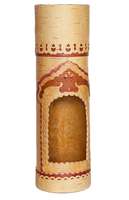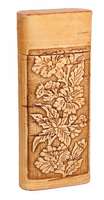Eyeglass & Bottle Cases & other gifts

|

|

|
Birch bark liquor bottle display case
On sale: $12.95
|
Birch Bark Eyeglass Case with Flowers images
On sale: $6.95
|
Birch Bark Eyeglass Case
On sale: $6.95
|

|
||
Eyeglass Case
On sale: $6.95
|
Traditionally birch tree was considered a wholesome and clean tree. It has been providing material for making dishes, spoons, and other kitchen utensils for quite a long time already. Birch bark has also been used in making storage bins, known as tues, to store dry and liquid goods.
Birch bark is often compared to natural leather. Accessories, clothes and shoes made of birch bark, which had undergone special treatment, provide the same level of comfort as the analogous articles made of leather. Soft, velvety surface of birch bark is pleasing to the touch, and its color harmony varies from dark chocolate to golden and creamy white.
There are four traditional and most common methods of decorative utilization of birch bark:
Wicker: Wickerworking is one of the most ancient crafts. It uses mostly one type of weaving, which is also the preferred method of carpet weavers, whereby the base thread is woven though each weft thread. Using thin strips of birch bark, Russian people used to make water-resistant shoes (boots and flat summer shoes) and flat round baskets for gathering mushrooms, as well as small baskets for gathering berries, assorted tableware, general household items, and even children’s toys.
Carving: Birch bark carving shows on small boxes for jewelry and tobacco. It can serve as the top layer for wooden travelling cases, and many other things. In the past, carving was done using only the basic carving tool knife, whereas now we are in possession of well thought out knives of different shapes and various types of handles.
Generally, all elements of carving should be connected to each other, and even the deepest layer must be visible. Some items get a silver foil of different colors as the under-layer.
Embossing: provides decoration on a birch bark tissue using a metall die. First dies were simple: circles, strips, thicker strips used to evoke an image of a road, and rhomboid shapes. Later on, more complicated shapes emerged such as birds, flowers, and houses. Using a set of dies, it was possible to emboss a whole picture on birch bark. By hammering upon the die on its top side one will leave a clear trace on the bark tissue. This kind of method was first described in the 18th century by mr. Bolotov – birch bark embossing master in his diary, after he visited The Great Ustug, one of the centers of birch bark industry in the past. Nowadays birchbark crafting masters utilize embossing too while decorating table and kitchen wares, and even prefer embossing to carving, or they can combine the two methods together. Visually, embossed birch bark items are decorative and attractive, as well as solid and water-resistant.
Painting: Many birch bark items are painted. Here one talks about tues, panels, bread baskets, jewelry boxes. Decorative painting appearing on various tues resembles the famous Tagil painting on metal trays from the Tagil region. The most popular designs involve the so-called Tagil flowers, which are bright, poignant color flowers framed by leaves and grass blades.


